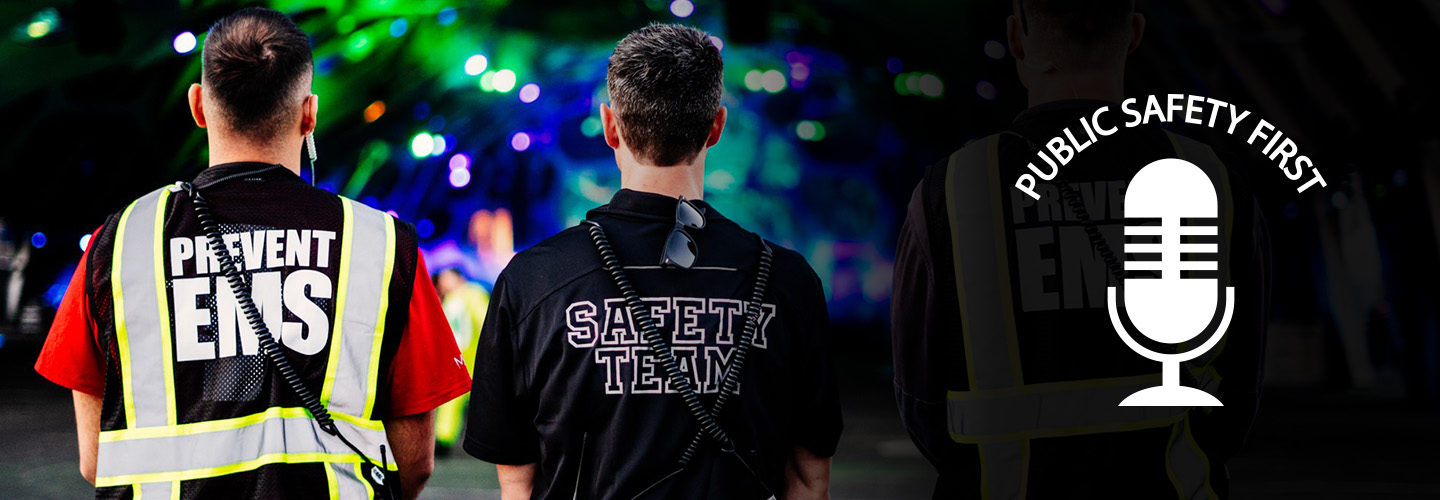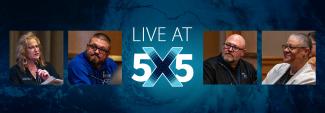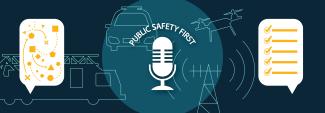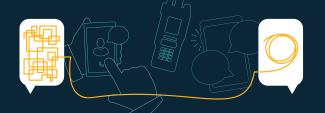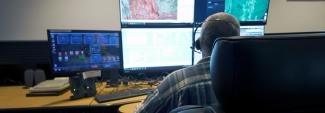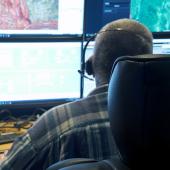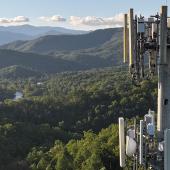Summary
Guest
Charles Hardnett, Senior Public Safety Advisor, FirstNet Authority
Cody Snow, President, Prevent Medical Solutions
Transcript
Preview
Episode 80 | Redefining event medicine and public safety with FirstNet
Narrator: You're listening to Public Safety First, a podcast to help you learn about the First Responder Network Authority and how you can be part of the future of public safety technology.
And now, your host.
Episode 80 | Redefining event medicine and public safety with FirstNet
Narrator: You're listening to Public Safety First, a podcast to help you learn about the First Responder Network Authority and how you can be part of the future of public safety technology.
And now, your host.
Charles Hardnett: Welcome to the Public Safety First podcast. I'm Charles Hartnett and I serve as the senior public safety advisor with the First Responder Network Authority. I'm joined today by Cody Snow of Prevent Medical Solutions. Prevent Medical Solutions provides medical services to large events such as marathons, festivals and sporting events. They're staffed by experienced emergency care physicians, paramedics, EMTs [emergency medical technicians], registered nurses, and other safety professionals. In addition to medical services, they provide public safety support such as unified command centers and incident management teams. Prevent Medical Solutions has been using FirstNet to support communications at their medical centers during large events for a number of years. Thanks for joining today, Cody. Welcome to the podcast.
Cody Snow: Appreciate it. Thanks for having me. I'm excited.
Charles Hardnett: Awesome. I just gave a very high overview of your organization, but can you tell us a little bit more about yourself and Prevent Medical?
Cody Snow: Yep. So, I'm currently the president of Prevent Medical Solutions and also the director of medical and unified command operations for an organization that provides some of the largest music festivals across the country. And on the other side of that, I'm an active engineer paramedic for a local fire department.
Prevent was formed about two years ago, and the intent behind Prevent Medical Solutions was to truly redefine how event medicine and public safety is practiced and delivered for the events of all sizes. We bring safety and medical operations to events of all sizes — marathons, construction sites, occupational health systems. We have truly become one of the leaders in public safety for events. And one of my biggest missions is to change the — air quotes — checkbox of medical and safety operations. A lot of different promoters will kind of look at it as a last check. “Oh yeah, let's throw some EMS in here.” Well, my saying has always been, “We don't throw medical and safety management into the operation. We build the entire operation around medical and safety planning.” So, switching that mindset is really the mission.
We have north of 450 employees now of all levels, including emergency physicians all the way to lifeguards. We encapsulate all public safety positions. In the last two years we've been operating, we've protected over 2 million attendees and staff, which is amazing to think about the gravity of that over a two-year span.
Charles Hardnett: That is awesome. So, it's obvious that you stay busy! I'm sure each event that you support, you know, offers a new experience for you and your team. So, thinking about these large-scale events and the complexity of your services changes with these events. So, I'm sure a lot of planning and preparation goes into getting ready for these events. Can you talk a little bit more about the level of coordination and pre-planning that you have to do with local public safety agencies, hospitals, event organizers, etc., in order to support each one of these events?
Cody Snow: Yeah, no, 100%. There's so much that goes into every event. And as you can imagine, multiple shows and planning are all kind of stepping on each other. Because we're managing events from coast to coast, every region has their own way of operating. Their own history, their own local protocol. So, the true key to success in this process is recognizing the unique needs and working all the planning, the management and all the pre-work in one big bubble, working with those local agencies around what those needs are. So, the coordination from local government, and all the different entities that have a stake, we have to look at each need, and the local jurisdiction needs.
The good news is we rinse, lather, repeat each year. So, events that are returning to a venue or specific area, the planning really starts from the first event, but right after that event we'll do after action meetings. So, a lot of good notes are hashed out there. And then, you know, 6 to 8 months ahead of the next show, we're already in the next planning phase. There really is no downtime when it comes to the large-scale events. 6 to 8 months out, we're already hammering all the fine details out. So, there's a ton that goes into it.
Charles Hardnett: That's amazing. So, you've already talked about a lot of services that your organization provides. At the core of that, it seems like communication would be there for the planning and the support of the event. What kind of communication challenges do you face in these unique environments?
Cody Snow: Oh, man. Communications obviously is the backbone of every single thing that we're doing. You know, fire, EMS, law enforcement. It is the one thing that has to be there. And you can see time after time, the one thing that usually fails the first and makes the entire event go off the rails is communication.
But for us, how do we come into an event which is extremely dynamic, where it's located, what's the infrastructure around it? And is an event supposed to even be in this place, right? So, first off, how do we bring an LMR [land mobile radio] radio system to a place that it never was? Or how do we bring in ours underneath the entire system that's already built? I mean, that's a major challenge in and of itself, but really the arduous task of how do we interop with local agencies? What are their systems? What do they do? What do they normally do? And it's so dynamic to get our transient operations to mesh with the local agencies. But at the end of the day, it has to be there, right? It's imperative to do it.
And second, we're looking at and actively testing gateways and interop channels. How do we all come together on a common tactical channel, regardless of the system, with a gateway in the middle? Well, now we all have channels that we can talk on.
Charles Hardnett: Right. That makes perfect sense. So, we’ve been talking about communication. And of course with FirstNet, that's a big part of our business. So, when did you join FirstNet and what motivated you to make that decision?
Cody Snow: So personally, I joined FirstNet even before Prevent Medical was created. I'm a fireman, so I understand communications. And we're in SoCal, so everything's always burning each year. And a million times I get the dreaded, "All circuits are busy,” you know, picking up the phone.
Back in the day, the craziest part was knowing you'd walk into an event and you have a limited timeline for your phone before it becomes a paperweight. If I didn't want to listen to music or take pictures, it's completely obsolete after that. I had a couple people around me that had FirstNet and I didn't, and they were just moving along like they normally did. And I'm sitting here with a paperweight. So that was kind of, in my mind, the click. So, I can come into an event now and not watch my bars disappear or seeing bars with no data behind it. And then now seeing how I’m able to utilize that at the events, absolute game changer. If I can get everybody around me on it, we have multiple lines of communication now.
Now, Prevent Medical Solutions is a FirstNet agency. Everybody’s getting up to that same level and we’re all able to communicate, which is an invaluable resource.
Charles Hardnett: So now that FirstNet has become one of your major resources, how are you using the service today?
Cody Snow: We’re using quite a bit of it. We travel right now with about 50 iPhones that all are PTT [push-to-talk] enabled. FirstNet is on our tablets, so all of our vehicles have an MDC [mobile data computer]. We’re using an iPad, so it’s running off FirstNet, which is awesome, gives us access to our CAD [computer-aided dispatch] systems and all of our back-end tracking.
So, we have a CAD system that is basically the hub of everything that’s going on from the command center down to the field. So, I can look using augmented reality through crowds to find incidents. I can make notes and do everything that normally a fire department or police department can do in the street, we’re doing at the events. So, all of those devices are running FirstNet.
The medical stations have either phones or smaller tablets that are running FirstNet, and pretty much the entire baseline infrastructure that we have is FirstNet-based. So, with that, we bought a CRD [compact rapid deployable] and the CRD is there as another level of contingency. If something was to happen, I can immediately fire that thing up and we're live again.
Paired with that is the MegaRange. I'm able to deploy that in a command center or throw it in the back of one of our carts and drive away and still have connection.
And then we use PTT almost every day. So, I'm able to get our entire team in the click of a button on comms and whether they're in New York and I'm over here or, you know, out on a boat somewhere, and if I have service or a Wi-Fi connection, we're good and I can talk to them. And it brings the entire team together. Being able to listen into the operations and things that are going on in states far away, that's a game changer right there. Those are the pieces we're utilizing right now with more on the horizon.
Charles Hardnett: Okay, great. So, a lot of events that you've supported have a lot of attendees, anywhere from tens to hundreds of thousands of people, which can lead to network congestion. Can you talk a bit about how you perceive FirstNet priority and preemption, ensuring your team to be able to communicate and access information like the CAD information you talked about, even when network resources are stressed in these environments with so many people there?
Cody Snow: Yeah, we are 100% testing the limits of every local network because we're bringing in hundreds of thousands of people all of a sudden to an area that never would have that. So, I mentioned I would walk into shows knowing that I might as well just leave my phone in my truck. And we used to have pockets that we would know there's some Wi-Fi and you would have to run to that area, connect to Wi-Fi and call. So now I worry less knowing that my device is in my pocket and I have connection. I can pick up the phone and with, you know, preemption and priority, I can call the command center. And I know that at the end of the day, that will work with all the redundancy we have built in. So, the CAD system running, you know, is a game changer. We're able to operate like we do on the street on a normal day, with no event at these major events. So, it’s pretty nice.
Charles Hardnett: Very nice. Do you support events in rural areas?
Cody Snow: Yeah. We do and we have.
Charles Hardnett: So, let's talk a little bit about that because in those areas you're dealing with the reliability of the services. And you mentioned, you're going into an area that's not used to handling that number of people. So, how do the FirstNet deployables help you supplement the coverage when you're in those areas?
Cody Snow: Yeah, rural events I love working on because it's a challenging piece. We have serviced a handful of the true rural events in the past. Some of these festivals and events where they're held, they don't normally have infrastructure to support tens of thousands or hundreds of thousands — parking lots, fields, destinations with limited connectivity for only what they're made to deal with. So, knowing that I can plan ahead in the pre-plan process, place a deployable request or even a site survey and the FirstNet team can get in there, see what the towers look like, see what the connectivity is, and be able to pull the trigger on a hot standby for a deployable. Or knowing our CRD is going to be there in conjunction with the deployable. That's awesome, because now it's not waiting for me to get boots on the ground and going, “yep, this doesn't work.” We had the pre-planning piece. We're proactive and not reactive in that mindset. So having that CRD deployed is amazing. But yeah, you have a whole team working for you for the most important part; communications.
Charles Hardnett: Yes, yes. So, let's switch to the other end of the spectrum, because I know you support events that are in urban areas also, like Las Vegas. There you have a densely populated area. There's coverage, but it also presents its own challenges to signals and communication. So, what happens in those areas for you?
Cody Snow: Yeah, I mean, Las Vegas is a beast in and of itself. It's bringing coverage into a concrete jungle, and that has its limitations and challenges. But over the years, we've learned a lot of things. You know, we bring in the deployables. One of the good things is that there is a highest point which looks out north, south, east, and west to bring coverage where it normally isn't. So, the CRD can fit in an elevator. So we'll get it to the top of the roof, or we'll bring it to one random spot that's interior.
We're able to bring in Cell Booster Pros. We're able to do that stuff to bring connectivity even in the dark areas. So, we're learning a lot.
Charles Hardnett: Yeah. Of course. And a major part of your business is mobility. You're going from one city to another, and so that brings us to interoperability. Can you talk a little bit about the importance of how interoperability supports your ability to travel to these different locations and have communications work instantly?
Cody Snow: Yeah, giving my team, whether it's push-to-talk on their personal phone, giving them a push-to-talk device, you know, is awesome. And then when we talk in a more concentrated level at some of the venues with fire, police, and EMS all on different channels, so how do I put another level on top of that with push-to-talk and the LMR system that we bring in? We're looking towards how do we bring everything together so it all talks and no one needs to triple their amount of radios for everyone else to use. We can come in, connect everything, put some common talk channels or interop channels within it, or we can come and patch them all together.
Charles Hardnett: Awesome. So, let's switch gears — CRDs, the Compact Rapid Deployables. These are mobile cell sites that provide FirstNet connectivity via satellite, and they don't require any commercial power, and they're much smaller than traditional deployables. What made you decide to purchase one? And talk a little bit more how you use it.
Cody Snow: Yeah, the CRD is a pretty cool piece of technology. One of the biggest reasons for purchasing it, just in my mind, incident management is redundancy and having a backup. Being able to call the FirstNet team for a deployable, there is obviously some lead time there. They have to activate a team and get on the road. Well, I wanted that middle ground. How do I turn something on and have a solution immediately? Well, that's the CRD. The cool thing about the CRD is I'm able to back my truck up to it, throw it on the hitch, and I drive away. If there was a need to get it into a tighter environment, it has the braking system on it. So, it's just pulling a giant wagon for the most part, and we can go to places we never had. I can fit it into most elevators, and I can go to the rooftop. I mean, you can't get a deployable up to a rooftop, but a CRD, it works out great.
We'll leave it usually by the medical center, meaning it's in a hot standby mode in the back. And if something was to happen, we have certain people on the team that know how to activate it, so they'll go flip the switches and boom, it's live. That just makes me feel better. It's just the flip of a switch and we're live.
We just did an event by the beach, and the coverage with all the buildings around it and a bunch of the things they had going on that day, 75% of the venue was dark. So, I realized it was a problem and we fired up the CRD. We put it right in the center of where we knew the coverage wasn't great, and I was back up to 95% coverage now. And the command center being pretty far away, we're able to put the MegaRange in there and we're live. So, we're able to use that CRD and just get it to the places that we never had before. The CRD is one of the coolest things, and a true game changer. We've had it about a year now, and I've used it 15 to 20 times.
Charles Hardnett: Wow. That's a lot! All right. So, you talked about your staff using the devices. Talk a little bit about what your staff is saying about utilizing FirstNet at these events.
Cody Snow: Well, I think it's funny you know, that hearing from the staff, I mean, that's the point, right? The fact that I can actually hear from them at shows now means that they have connectivity —
Charles Hardnett: Right. This is good.
Cody Snow: Yeah. It's perfect. You're calling me to complain about something, awesome. You have connectivity. This is perfect. Well, that's the goal. Instead of with the paperweights, they have phones that are able to use it.
I watched it a couple weeks ago. One had FirstNet, the other didn't, and I watched the conversation of, “Hey, how are how are you sending text messages?” And it's like, “Oh, it's FirstNet.” It's the proof of concept. It's showing that, yeah, this works great. So, they're seeing the true benefit of it instead of just hearing through word of mouth. It's tangible. They put their hands on it and they can go, “wow, I can do a lot of stuff with this.” So, it's been great.
Charles Hardnett: Okay. Thanks for that. What advice would you share with other public safety agencies and emergency medical providers that were thinking about joining FirstNet? What would you tell them?
Cody Snow: The biggest thing that I would relay to someone else that's investigating this is ask for a proof of concept. Road test it, put it in your hand, see how it works, because that answers a lot of questions without even having to ask them, right. You need to use FirstNet and have them come out, show the operation, show all the pieces. You can walk around with a device in your hand, try PTT, see how your agency can integrate, and you'll probably think of way more solutions than you realized until you have it in your hands. So, that was the biggest thing. I need to know how it works in my specific area. Just test it, figure it out, and then everybody can start talking about your specific needs in your area.
Charles Hardnett: That's a great point. And I'll just add that with the Authority, we do have a solution experiences program specifically for that point. So, we work with agencies and with AT&T to supply devices to test applications and test ideas. So, they can just reach out to their senior public safety advisor that they have for their region. So, I think that's a great input. Thanks. Is there anything else you'd like to share with our listeners?
Cody Snow: The one thing that I will say is FirstNet is on the fast track to even bigger and better than where you guys are at now, which is very impressive. It's very exciting to see, and the issues that we all face in the public safety space are heard. And I would just recommend, if you're listening to this and you are that decision maker or can help guide your agency into a certain direction, keep your finger on the pulse and stay ahead of the curve, because I think you'll see and feel the benefit.
Charles Hardnett: All right. It's been a pleasure. As always, it's fun to talk with you Cody and learn more from you. So, thanks so much for joining us today. And everybody, we thank you all for listening and enjoy the rest of your day, wherever you are and whenever you're listening to this podcast. Thank you.
Narrator: Thanks for listening today. We're excited to have you join our podcast community. Make sure to subscribe on iTunes, SoundCloud, and YouTube. You can learn more about the First Responder Network Authority at FirstNet.gov and learn about FirstNet products and services at FirstNet.com.


